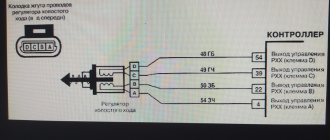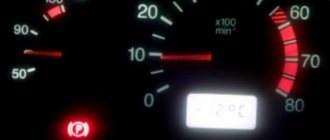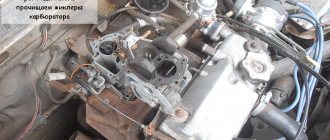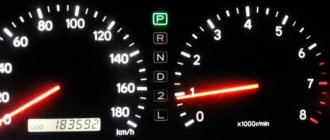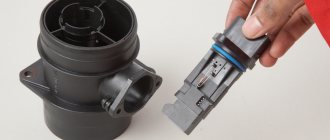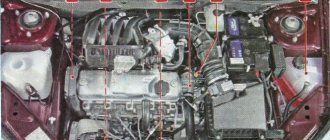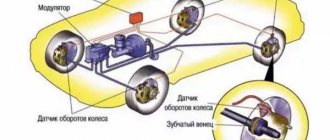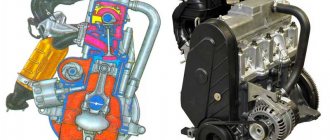General information
Any car owner sooner or later faces a problem when the idle speed of the car fluctuates.
If the car has been in use for several years, then you will inevitably have to face this problem. In order to determine the reason for this breakdown, you need to carefully understand the design of the car. If, when starting the engine of a Lada Granta, it is observed that as it warms up, instead of smoothly decreasing, the speed simply disappears for a few seconds, and then operates spasmodically, then the reason is 60% precisely because the idle speed fluctuates .
However, the problems disappear after the engine continues to function. All visible symptoms suddenly disappear and the engine continues to operate normally. However, the problem will repeat itself every time it is started and will not go away.
With each subsequent use of the car, this problem will only get worse. Therefore, you should not postpone its solution indefinitely, as in the future this will lead to very expensive repairs.
It's a disease?
On some copies of the Lada Granta model, even on those that have just recently rolled off the production line, a problem such as floating speed at idle speed of the engine may be observed.
The following two tabs change content below.
- About the expert:
Renault car expert
I own a Renault Megane 2, before that there were Citroens and Peugeots. I work in the service area of a dealership, so I know the car inside and out. You can always contact me for advice.
First causes of malfunction
Most often, cars that have an electronic fuel injection system suffer from this problem. The root cause of this situation is that there is a constant suction of excess air, the volume of which continues to constantly increase, which, in turn, leads to breakdown.
The electronic unit, or electronic sensor, is responsible for fuel injection and at the same time calculates the entire volume of air entering the cylinders. In addition, based on the indicators provided by other sensors, the electronic unit opens the injection solenoid valves for a certain time.
The problem may lie in the incorrect operation of the crankcase ventilation valve.
Consequently, when excess air enters them, the sensor responsible for the throttle position shows the motorist that this task is impossible. At the same time, the temperature sensor indicates that the engine should have already left the warm-up system, therefore, it needs much less fuel. It is during this period that the idle speed of the car fluctuates. We can conclude that this happens due to the fact that the electronic unit simply does not know where to supply excess air.
The second reason why idle speed fluctuates is constant jamming. It occurs directly in the crankcase ventilation valve. If the malfunction depends on this, the frequency with which the automatic power control sensor operates is disrupted. As a result, the sensor shows instability of engine speed. When in a faulty state, they range from 1,200 to 800 rpm.
Engine speed and driving speed
How did I answer the question: at what speed should I drive and when should I change gears on a manual? Because Everyone gives different advice.
Manual cruise gear ratio (for reference: automatic) 1 — 3.818 (4.58) 2 — 2.158 (2.96) 3 — 1.481 (1.91) 4 — 1.121 (1.44) 5 — 0.886 (1.00) 6 — no (0.74)
Next, I noticed that 2500 rpm corresponds to 60 km/h in 3rd gear. From here you can recalculate the speeds in other gears. The result is a table like this. I used arrows to draw the speed of the car when driving no higher than 2500 rpm
When driving no higher than 3000 rpm
Both options are recommended by different drivers. In my opinion, up to 2000 - vegetable up to 2500 - semi-vegetable up to 3000 - still quiet
Here is another table from which you can find out the changes in engine speed when switching from one gear to another.
the same table, but for 2500 rpm.
With the rising cost of automobile fuel, many motorists began to think about effective ways to ride their iron horse in order to spend as little money as possible on refueling it. In this article, we will tell you what the most economical car speed is and what needs to be done to reduce the average fuel consumption of a car.
Elimination of floating speeds
If you do not want to take your car to a service station and are going to do all the work yourself, then you will definitely need tools such as:
- heads with a ratchet, and their size should be 6 and 8;
- a special key called TORKS T-25;
- neutral sealant, when purchasing, pay special attention to ensure that it is odorless;
- FUM tape, its thickness should be 0.0075 mm, it is used mainly by plumbers to make a seal on any thread;
- Silicone Grease;
- a clamp with a special screw tensioner, its size must be no less than 22x27, this is necessary in order to create reinforcement for the channel hose, which, in turn, is necessary for idling operation.
You need to disconnect and remove the throttle cable stopper from the lever. This work must be done specifically on the throttle assembly. Next you will need to remove the resonator and air pipe. Using TORX T-25 heads and bits that were previously purchased, you need to unscrew the air filter shell. To be able to carry out this work with maximum convenience, you need to remove the wire from the exhaust receiver and all associated fasteners going to the throttle assembly.
To fix this, you will have to disconnect the hose leading to the idle air passage.
Next, proceed to disconnect the hose leading to the idle air passage. Taking the T-25 TORX again, unscrew several screws that secure the receiver to the remote control. In order for this work to be done without much effort, pull it a little to the side. It is necessary to take into account that it will not be possible to completely remove it for the simple reason that the heater hoses pass nearby.
Now, having removed the obstacle from the throttle assembly, unscrew all the bolt heads using a ratchet head to do this job. Only after this will it be possible to remove the remote control and remove the rubber rings that serve as a seal at the two ends of the throttle valve. All grooves need to be cleaned as much as possible and the FUM tape should be wound around them in a circle, about 15 times, and on the small pipe - about 10 times.
Please note that there is also a rubber seal on the fitting near the exhaust receiver body, which will need to be removed and lubricated with sealants. After it dries, use a thin tie to outline the body of the elastic.
Only after completing this work can you begin to fully assemble the elements into a single whole. It would also be useful to use a clamp when securing the channel hose and the tube leading to the vacuum booster. This is necessary to further prevent air leaks in the connections.
Other reasons for unstable engine operation Grants
Floating speeds and tripping are not the only problems associated with the functioning of the Lada Granta engine. There are other situations.
Engine does not develop power
This problem is not relevant if the car is new and is being run-in. Until 5 or 8 thousand kilometers, the engine should not gain maximum power. And for the first 2 thousand kilometers, it is not at all recommended to raise the tachometer needle above the 3000 rpm mark.
It happens that when accelerating a car:
- does not gain the required power;
- moves as if there is a trailer behind it;
- When accelerating it sticks.
These are signs of low pressure in the fuel system. It is recommended to replace the fuel filter with a new one. The cause may also be low-quality gasoline. The Grant is equipped with an electronic gas pedal - its malfunction can also cause insufficient engine power.
Engine knock
A knocking sound in the engine may occur due to vibration of the crankshaft pulley. There is no point in repairing it; it is better to replace it with a new one. If the cause is a loose timing belt, you can fix the problem by tightening it. A knocking sound in the engine may occur due to a loose flywheel, but this happens quite rarely. Wear of connecting rods, bearings, pistons and crankshaft also leads to a characteristic dull knock. If the problem is with these components, then they require replacement.
Unstable engine operation can occur due to the natural wear and tear of engine parts or improper running-in. In any of the described cases, it is necessary to carry out a comprehensive diagnosis, with the help of which the exact cause can be established and then eliminated. To carry out self-diagnosis, you need a special scanner.
If the engine is misfiring, then it is not recommended to delay solving this problem. Driving with the engine partially working or not working at all is prohibited, as it can lead to more serious malfunctions and expensive (possibly major) repairs of the internal combustion engine.
Car : Lada Granta. Asks : Alexey Dudyrev. The essence of the question : Does the idle speed fluctuate?
I recently bought myself a Lada Granta, and the revs began to fluctuate, in short, the car became somehow unstable at idle. Tell me what could be the cause of this malfunction and how quickly it can be fixed?
IAC diagnostics, idle speed sensor
Use a pxx tester to verify the presence of floating rpm
To check whether the speed on the Lada Granta is floating, look at the IAC sensor. It is located on the throttle body, therefore, in the same place as the sensor responsible for the throttle position. It is secured with two mounting screws. In order to verify its functionality, one multimeter will be enough.
To begin diagnostics, you need to turn off the ignition and disconnect the block to which the wire from the sensor leads, and, using a multimeter, measure the resistance level between the contacts of the regulator.
If the vehicle readings are normal, it should be within approximately 80 ohms. In the same case, if the indicators turned out to be significantly higher than the IAC norm, it will be necessary to replace it.
The idle speed sensor, abbreviated as IAC, is the same idle speed control, or IAC. Its immediate purpose is to stabilize and automatically adjust the idle speed of the Lada Grant, which is used in the daily functioning of the car. In appearance, it is an electric motor equipped with a cone-shaped needle.
At the moment when the ignition is turned on directly, the rod located on the regulator fully extends and rests against a specially made calibration hole. It is located directly in the throttle pipe. After this, the sensor begins to count steps until the required time and returns the valve to its original state upon completion of operation.
It is necessary to take into account that when you start warming up the Lada Granta engine, the sensor readings should not exceed 50 steps. If their volume is much smaller or larger, it means that air volumes are constantly changing, which in the future can lead to significant damage.
Checking the idle air control
| If the engine runs rough at idle, then the cause may be a faulty idle speed control sensor. Before replacing it, you can check the IAC with your own hands. |
The IAC is an actuator and its self-diagnosis is not provided for in the system. Therefore, if the idle speed control malfunctions, the “CHECK ENGINE” lamp does not light up. Symptoms of IAC malfunctions are in many ways similar to TPS (throttle position sensor) malfunctions, but in the second case, most often the “CHECK ENGINE” lamp clearly indicates a TPS malfunction.
Testing IAC using a multimeter
Checking the IAC with a homemade tester
However, you can make a simple device for checking IAC yourself. You only need a 6V AC transformer from your mobile phone charger. Using the switches alternately, we check the forward and reverse strokes of the IAC rod. If the unit is working properly, the lamp (6V/0.6A) barely shines. A bright light indicates that the rod is jammed and needs to be cleaned and lubricated or replaced. Detailed diagrams and seals from the author. If the IAC turns out to be faulty, then choose a new one. Photo source: Key words:
Why does the Lada Granta fluctuate at idle and what to do
If the active use of the car continues for more than 3 years, the owner of the Lada Granta will not be able to avoid the problem of floating speed.
But in order to find out the true cause of what is happening on your own, you need to have at least basic knowledge about the design of your car. When starting the engine, you can observe the following picture: as it warms up, instead of a gradual decline, the speed decreases sharply, and then suddenly begins to change abruptly. In 60% of such cases, the reason is the occurrence of floating revolutions.
In addition, the phenomenon often disappears immediately after the engine starts working. At the same time, visible manifestations disappear and everything returns to normal. But the situation will repeat itself in the future, and more than once.
Over time, the problem will get worse, so don’t put it off for too long. As a result, you will have to spend a lot on expensive repairs.
Optimal minimum engine speed for Lada Granta
| If you trust the technical characteristics, the maximum speed of the VAZ 2190 is 167 km/h for the VAZ-11183 engine (82 hp), 172 km/h for the VAZ-11186 (87 hp), 175 km/h for the VAZ-21126 with automatic transmission and 181 for the same engine with manual transmission. And what is the maximum speed of the Lada Granta that a popular test will actually help determine. |
The Lada Granta “norm” with an 87 horsepower engine took part in the tests .
The first gear is long, so it allows you to quickly accelerate the car to the maximum permissible speed in the city. The second gear allows you to accelerate the car to 90 km/h. Third and fourth gears dynamically accelerate the car to 140 km/h. Fifth gear allows you to accelerate the car to 190 km/h (174 km/h according to GPS), and the speed gain is no longer so active. Upon reaching maximum speed, it was decided to check a number of parameters:
In conclusion, I would like to note that at top speed Grant behaves quite predictably, but not as confidently as, for example, at a speed of 110 km/h. At maximum speed, the car begins to respond to steering turns late, and to completely stop the Lada Granta, the brakes will take much longer than during normal driving. In addition, driving at such a speed is unprofitable, and also not according to the rules, and most importantly, it is not safe.
By the way, if you completely soundproof the Lada Grant, the weight of the car will increase by 50-80 kg, which will also affect the maximum speed to some extent.
Almost every driver is well aware that the life of the engine and other components of the car directly depends on the individual driving style. For this reason, many car owners, especially beginners, often think about what speed is best to drive at. Next, we will look at what engine speed should be maintained, taking into account different road conditions during vehicle operation.
Read in this article
So why is this happening
Root causes of problems
The most common situations in which floating speeds occur:
- Cars with a built-in electronic fuel injection system suffer from such problems much more often than others. And this happens due to the constant suction of excess air, the volume of which still increases, which leads to the formation of a malfunction. The sensor responsible for gasoline injection simultaneously calculates the volume of air entering the cylinders. Based on these and some other indicators of the sensors, the electronic unit opens the electromagnetic injection valves for some time. It follows from this that when there is an excessive amount of air in them, the sensor, which is responsible for the position of the throttle valve, shows the driver that the task assigned to the system is impossible - the check light is on. During this, the temperature sensor indicates that the engine is exiting the warm-up mode. This indicates that it needs less fuel. Just at such a moment, floating speed appears in the car at idle, because the electronic unit does not understand what to do with the accumulated excess air in the system.
- This reason also partially relates to air suction and occurs mainly on 16-valve engines. The main place where air leaks still occur is the gluing contour of the receiver elements. Even minor damage to this area will lead to unstable operation of the motor.
- Constant jamming also easily becomes a reason for the occurrence of floating speed. It occurs in the crankcase ventilation valve. Therefore, if the reason is precisely this phenomenon, the systematic operation of the automatic power regulation sensor is disrupted. As a result, the same sensor signals instability of the engine. In a faulty state, the speed ranges from 1,300 to 900 per minute.
- In models with a carburetor engine, floating speed occurs due to a violation of the control of the servomotor. To correct this problem, simply unscrew the adjustment bolts in the area of the servomotor where the sensor points to the loose drive.
- Low pressure in the fuel system causes the same problems.
- Breakdowns in the ignition system are sometimes also classified as causes of floating speed. The problem is primarily related to high-voltage wires and spark plugs. But only with a visual inspection will it be possible to understand whether they are really the problem.
- A breakdown of the IAC (idle air regulator) causes floating speeds, because it is responsible for their initial stability. The element is inexpensive and can be replaced, so there may not be any significant problems with this.
- The electronic gas pedal has a lot of disadvantages, especially if tuning the car is only in the process, but the car is actively used. Floating speed is a fairly common occurrence in such a situation.
On a Grant automatic transmission, the revs fluctuate at low throttle
Welcome to ChipTuner Forum.
Theme Options
Eldar2018
| Unique distance learning system “ Alexei Pakhomov School of Diagnostics ”. Training course “Theory of internal combustion engines” . Theory of internal combustion engines “from scratch”. Video, high-quality color illustrations, texts. To learn more | Unique distance learning system “ Alexei Pakhomov School of Diagnostics ”. Training course “Auto electrician from scratch” . A course designed for a person with “zero” knowledge in the field of auto electrics. To learn more |
Michael_
fanatic
Sergey_karb
fanatic
Vasyan
I did as you said, drilled a 2 mm hole. I drove for about an hour, the car was simply unrecognizable, the idle speed stopped decreasing, the gas pressure disappeared when driving in a traffic jam, by the way, the consumption at idle did not increase.
Thank you very much, if it weren’t for you I would still be driving from diagnostician to diagnostician in a twitchy car
, I would listen to their stories that there are no errors and perhaps there is an air leak somewhere.
Why drill the throttle body?
There is a more elegant solution:
Install a bypass from a thin hose - the tube is stuck BEFORE the throttle, the other end - AFTER the throttle - into the receiver. It’s even better to stick a small tap from a dropper into a thin tube to regulate the air flow. When the engine is warm, you will find the best valve position.
Fluctuations in speed most likely occur due to a clogged crankcase ventilation nozzle. There is a plastic bead jet with a 1.7 mm hole.
In general, this behavior of the internal combustion engine is well monitored like this: You drive in first with the gas released, just using the clutch. The car will start to jerk.
vkv767
vkv767
Just hanging up is NOT ENOUGH
You need to play with the diameter of the open hole.
vkv767
Hummer-74
Vasyan
Pavel_b
Hummer-74
Hummer-74 trolled me in the same way in another thread, namely in this one:
https://chiptuner.ru/forum/showthread.php?t=103890
I am duplicating here my first message from there, slightly updated:
Kalina-2, automatic transmission, 0, Itelma ECU 21126-1411020-90, stock firmware (I464AI09), E-gas. When you press the gas pedal in the range of 0.3%, the revolutions begin to build up in a beautiful sine wave (looked at on the stand) from 600-700 to 1200-1300. When pressed further, the revolutions simply increase to 1200. 1300 and the effect completely disappears. The effect has been present on the car, apparently, almost since its release (late 2013). I broke the whole brain of myself and the only competent Kemerovo diagnostician, he no longer wants to communicate with me. When working in this area, the remote control opens and closes in a sinusoid from 0 to 6-7%. Other parameters (air flow, injection duration, SOP, voltage in the BS, etc.) also fluctuate accordingly.
Errors that I saw through the BC during the entire period of operation: - misfires (extremely rare) - P0327 (low level of the DD signal, went away after replacing the DD) - P2188 (rich mixture at idle, appeared quite a long time ago, does not light up on the dashboard, just hangs in the memory, is still there) - P1335 (incorrect position of the remote control, extremely rare, over the entire 6 years of operation, maybe 4 times, and only when driving on a long climb)
Errors that I have never seen: - according to the DC - according to the mass air flow sensor (except for those cases when he threw it back on purpose) - according to the air flow sensor, DPKV
What I did: - reset the ECU with initialization (repeatedly) - changed the ECU itself to a similar one at a VAZ dealer service station - cleaned and tightened the ECU mounting studs (they are also the ECU mass) - cleaned and tightened the mass of the ignition harness - added additional masses under the hood (generator - body, battery-body, battery - engine, engine-box. ) - put electrolytes 2200 uF x50V x2 in the ignition harness (for the common + harness and a separate one for ground) - changed all the filters - changed the spark plugs - checked the pressure in the rail, washed injectors - cleaned the mass air flow sensor with a special composition for the mass air flow sensor (not for the remote control) (and yes, we have a frequency mass air flow sensor with a measuring element in the form of a thread, which can be cleaned with a special composition) - threw the mass air flow sensor with a Granta with a similar engine - threw up the gas pedal with the same Grants - cleaned the DZ with removal - replaced the DZ with the same slightly used one (and replaced the gasket under it) - checked for leaks in the manifold (there are none) - replaced the DZ - bought one new coil and plugged it in one by one instead of each, every time checking for the presence of the above-described jamb - installed a PCV valve
UDC works fine (looked through OpenDiag several times). The engine does not tune up, there are no extraneous noises at all, except that the hydraulic compensators are knocking (well, the engine has already passed more than 100 thousand) I only use 95 gasoline (mainly Gazprom), I have never smelled anything else. Previously, the jamb completely disappeared when the air conditioner was turned on (the revolutions rose to 1000), but now it is already there with it turned on. The jamb is absent until the engine warms up to about 40*C. The jamb is only present in this range of gas pedal pressure and gradually intensifies. Traction is excellent, acceleration is excellent, consumption is not increased.
He provided a log taken using OpenDiag, which specifically demonstrated the presence of a jamb on a car parked in P. They didn't even look at him. “It’s inconvenient for us, we earn our living from this, and in general this OpenDiag is crap.” Why is he bad? Well, it takes readings every 300 ms, not every 100 or whatever your scanners can do. And what? Will he show different graphs? You can still see a beautiful sinusoid, even if it is slightly broken. Earn your bread in peace! At least they could tell me where to dig.
But respected local specialists simply don’t know how to solve the problem, so they make up mysteries.
Rare messages in the thread about the spread of parameters of AvtoVAZ engines are delivered. HBO has nothing to do with it, leave him alone.
Thirteenth
Hummer-74 trolled me in the same way in another thread, namely in this one:
https://chiptuner.ru/forum/showthread.php?t=103890
I am duplicating here my first message from there, slightly updated:
Kalina-2, automatic transmission, 0, Itelma ECU 21126-1411020-90, stock firmware (I464AI09), E-gas. When you press the gas pedal in the range of 0.3%, the revolutions begin to build up in a beautiful sine wave (looked at on the stand) from 600-700 to 1200-1300. When pressed further, the revolutions simply increase to 1200. 1300 and the effect completely disappears. The effect has been present on the car, apparently, almost since its release (late 2013). I broke the whole brain of myself and the only competent Kemerovo diagnostician, he no longer wants to communicate with me. When working in this area, the remote control opens and closes in a sinusoid from 0 to 6-7%. Other parameters (air flow, injection duration, SOP, voltage in the BS, etc.) also fluctuate accordingly.
Errors that I saw through the BC during the entire period of operation: - misfires (extremely rare) - P0327 (low level of the DD signal, went away after replacing the DD) - P2188 (rich mixture at idle, appeared quite a long time ago, does not light up on the dashboard, just hangs in the memory, is still there) - P1335 (incorrect position of the remote control, extremely rare, over the entire 6 years of operation, maybe 4 times, and only when driving on a long climb)
Errors that I have never seen: - according to the DC - according to the mass air flow sensor (except for those cases when he threw it back on purpose) - according to the air flow sensor, DPKV
What I did: - reset the ECU with initialization (repeatedly) - changed the ECU itself to a similar one at a VAZ dealer service station - cleaned and tightened the ECU mounting studs (they are also the ECU mass) - cleaned and tightened the mass of the ignition harness - added additional masses under the hood (generator - body, battery-body, battery - engine, engine-box. ) - put electrolytes 2200 uF x50V x2 in the ignition harness (for the common + harness and a separate one for ground) - changed all the filters - changed the spark plugs - checked the pressure in the rail, washed injectors - cleaned the mass air flow sensor with a special composition for the mass air flow sensor (not for the remote control) (and yes, we have a frequency mass air flow sensor with a measuring element in the form of a thread, which can be cleaned with a special composition) - threw the mass air flow sensor with a Granta with a similar engine - threw up the gas pedal with the same Grants - cleaned the DZ with removal - replaced the DZ with the same slightly used one (and replaced the gasket under it) - checked for leaks in the manifold (there are none) - replaced the DZ - bought one new coil and plugged it in one by one instead of each, every time checking for the presence of the above-described jamb - installed a PCV valve
UDC works fine (looked through OpenDiag several times). The engine does not tune up, there are no extraneous noises at all, except that the hydraulic compensators are knocking (well, the engine has already passed more than 100 thousand) I only use 95 gasoline (mainly Gazprom), I have never smelled anything else. Previously, the jamb completely disappeared when the air conditioner was turned on (the revolutions rose to 1000), but now it is already there with it turned on. The jamb is absent until the engine warms up to about 40*C. The jamb is only present in this range of gas pedal pressure and gradually intensifies. Traction is excellent, acceleration is excellent, consumption is not increased.
He provided a log taken using OpenDiag, which specifically demonstrated the presence of a jamb on a car parked in P. They didn't even look at him. “It’s inconvenient for us, we earn our living from this, and in general this OpenDiag is crap.” Why is he bad? Well, it takes readings every 300 ms, not every 100 or whatever your scanners can do. And what? Will he show different graphs? You can still see a beautiful sinusoid, even if it is slightly broken. Earn your bread in peace! At least they could tell me where to dig.
But respected local specialists simply don’t know how to solve the problem, so they make up mysteries.
Rare messages in the thread about the spread of parameters of AvtoVAZ engines are delivered. HBO has nothing to do with it, leave him alone.
There seem to be no errors in the DPRV, because no DPRV.
I also had a similar increase in speed. The internal combustion engine has covered 150 tkm.
1. Check for leaks in addition to the throttle (small branch of the crankcase ventilation) or the throttle opening angle sensor is lying. 2. See how the brake pedal sensor and clutch pedal sensor work
(these sensors greatly influence driving characteristics, especially when starting off)
In my case, the crankcase ventilation hose (the small one with the nozzle) was clogged.
After replacing the small hose with a regular one without a jet, DK1 and DK2, everything returned to normal.
Article rating:
Lada Granta speed floats at idle Link to main publication
Related publications
- How to disassemble the interior rear view mirror
Independent search for the cause
What to pay attention to:
- Check the MAF (mass air flow sensor).
- Examine the IAC.
- Examine the wiring of the DS (speed sensor).
- DPKV (crankshaft position sensor) is the next object of inspection. But the reason, most likely, is not in it specifically, but in its chip or wiring.
- The TPS (throttle position sensor), an element of the throttle assembly, must also undergo a thorough inspection in such a situation. Perhaps a simple cleaning is needed.
- Check high voltage wires and spark plugs.
Once the cause is identified, the problem must be corrected. Your actions in this case depend entirely on what exactly went wrong.


